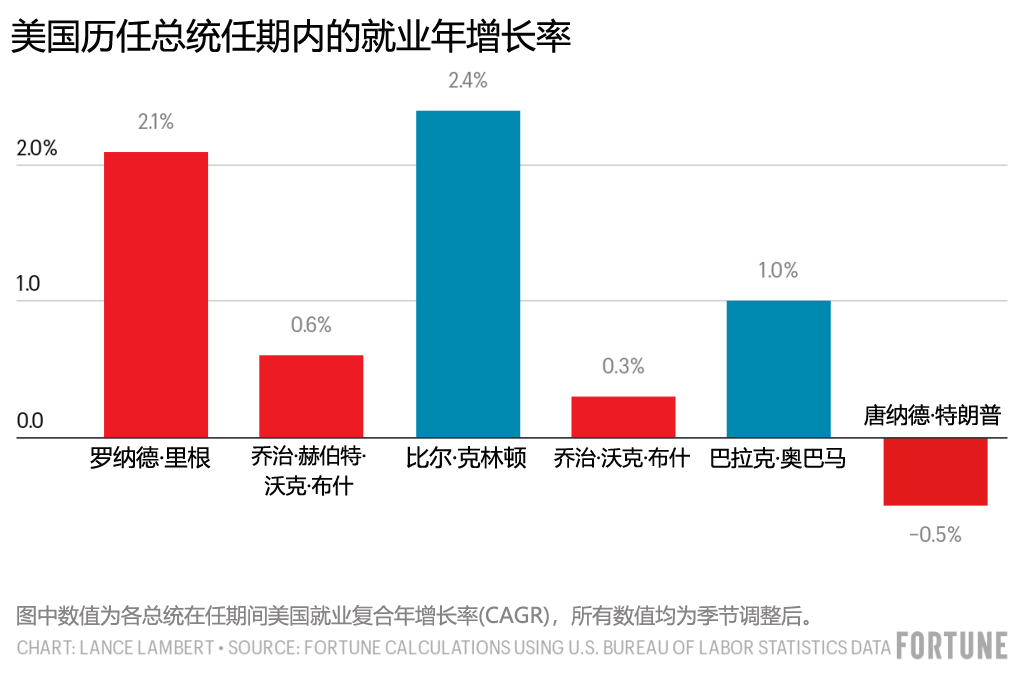纵观美国总统唐纳德•特朗普任期内的前三年,其实他在经济方面做得相当不错——国民收入翻倍、美国失业率达到50年来的最低水平,实现了美国有史以来持续时间最长的经济增量。
但新冠疫情却让这一切戛然而止。
在2020年2月至4月期间,美国失业率当即飙升至80年来最高水平,就业人数从1.525亿急速降至1.305亿,失业人口达2220万,瞬间倒退回1999年水平。
自此以后,美国经济虽然有所复苏,但其恢复的1230万个岗位依然无法抵消疫情损失。
特朗普也就此成为了二战以来第一位在任职期间致使美国就业率下降的总统。上一次美国就业低迷还要追溯到赫伯特•胡佛离任时,即1933年经济大萧条(Great Depression)期间。
特朗普于2017年1月就职时,美国的就业人数为1.456亿。今年1月8日,美国劳工统计局(Bureau of Labor Statistics)发布了1月20日当选总统乔•拜登就职前的最后一份就业报告。报告显示,2020年12月的美国就业人数为1.426亿,比特朗普就职时减少了300万。

为了便于比较,《财富》杂志统计了自里根总统以来的美国就业年增长率以供参考。由图可见,在奥巴马执政的八年里,美国就业增长折合成年率固定在1%左右。特朗普上任之初,这一增长率确实有所提升:截至2020年2月,美国就业增长折合成年率已达1.5%。然而,如今特朗普卸任之际,该数值只有-0.5%。
简而言之,特朗普在2016年美国总统竞选之初的那个野心勃勃的誓言,四年后深受疫情戕害,最终幻灭一空。(财富中文网)
编译:陈怡轩
纵观美国总统唐纳德•特朗普任期内的前三年,其实他在经济方面做得相当不错——国民收入翻倍、美国失业率达到50年来的最低水平,实现了美国有史以来持续时间最长的经济增量。
但新冠疫情却让这一切戛然而止。
在2020年2月至4月期间,美国失业率当即飙升至80年来最高水平,就业人数从1.525亿急速降至1.305亿,失业人口达2220万,瞬间倒退回1999年水平。
自此以后,美国经济虽然有所复苏,但其恢复的1230万个岗位依然无法抵消疫情损失。
特朗普也就此成为了二战以来第一位在任职期间致使美国就业率下降的总统。上一次美国就业低迷还要追溯到赫伯特•胡佛离任时,即1933年经济大萧条(Great Depression)期间。
特朗普于2017年1月就职时,美国的就业人数为1.456亿。今年1月8日,美国劳工统计局(Bureau of Labor Statistics)发布了1月20日当选总统乔•拜登就职前的最后一份就业报告。报告显示,2020年12月的美国就业人数为1.426亿,比特朗普就职时减少了300万。
为了便于比较,《财富》杂志统计了自里根总统以来的美国就业年增长率以供参考。由图可见,在奥巴马执政的八年里,美国就业增长折合成年率固定在1%左右。特朗普上任之初,这一增长率确实有所提升:截至2020年2月,美国就业增长折合成年率已达1.5%。然而,如今特朗普卸任之际,该数值只有-0.5%。
简而言之,特朗普在2016年美国总统竞选之初的那个野心勃勃的誓言,四年后深受疫情戕害,最终幻灭一空。(财富中文网)
编译:陈怡轩
During the first three years of Donald Trump's presidency, the economy did quite well. The unemployment rate hit a 50-year low, income growth doubled, and the economic expansion he inherited grew into the longest in American history.
But that all came to a shrieking halt when COVID-19 hit.
In a two-month period, February to April 2020, the unemployment rate soared to an 80-year high and the number of employed Americans fell from 152.5 million to 130.3 million. Those 22.2 million job losses set U.S. employment back to 1999 levels.
Since, the economy has moved from contraction to expansion and seen 12.3 million jobs return. However, it hasn't been enough to offset the job losses that occurred during the pandemic.
That means that Trump will become the first post–World War II president to see employment fall during his presidency. It last occurred when Herbert Hoover left office in 1933 amid the early years of the Great Depression.
When Trump took office in Jan. 2017, U.S. employment was at 145.6 million. On January 8, the U.S. Bureau of Labor Statistics released its final jobs report before the Jan. 20 inauguration of President-elect Joe Biden. It shows in December there were 142.6 million employed Americans, down 3 million from Trump's own inauguration.
For comparison purposes, Fortune annualized the job gain rates under all the past leaders since Reagan. During Obama’s eight years at the helm of the nation, U.S. employment maintained a 1% annualized return. That growth level did start to climb during the Trump years; as of February 2020 employment was increasing on a 1.5% annualized basis during his presidency. Yet in the final tally Trump will leave office having overseen a -0.5% annualized job growth rate.
Simply put: The historic jobs boom that candidate Trump promised on the campaign trail in 2016 was yet another victim of COVID.






